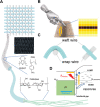Self-Powered Smart Textile Based on Dynamic Schottky Diode for Human-Machine Interactions
- PMID: 36782105
- PMCID: PMC10104626
- DOI: 10.1002/advs.202207298
Self-Powered Smart Textile Based on Dynamic Schottky Diode for Human-Machine Interactions
Abstract
The growing demand for sustained self-powered devices with multifunctional sensing networks is one of the main challenges for smart textiles, which are the critical elements for the future Internet of Things (IoT) and Point of Care (POC). Here, cellulose-based smart textile is integrated with dynamic Schottky diode (DSD) to generate sustained power source (current density of 8.9 mA m⁻2 ) for self-powered built-in sensing network. In response to normal and shear motions, a pressure sensor with a sensitivity of 0.12 KPa⁻1 and an impact sensor are demonstrated, respectively. The woven structure of the textile contributes to signal amplification, which can also form a matrix of sensing elements for distributed sensing. The proposed strategy of fabricating self-powered and multifunctional sensing networks with smart textiles shows tremendous potential for future intelligent society.
Keywords: biaxial detection; dynamic Schottky diodes; self-powered; sensing network; smart textile.
© 2023 The Authors. Advanced Science published by Wiley-VCH GmbH.
Conflict of interest statement
The authors declare no conflict of interest.
Figures




Similar articles
-
Highly Wearable, Breathable, and Washable Sensing Textile for Human Motion and Pulse Monitoring.ACS Appl Mater Interfaces. 2020 Apr 29;12(17):19965-19973. doi: 10.1021/acsami.0c03670. Epub 2020 Apr 16. ACS Appl Mater Interfaces. 2020. PMID: 32275380
-
Woven Wearable Electronic Textiles as Self-Powered Intelligent Tribo-Sensors for Activity Monitoring.Glob Chall. 2019 Nov 14;3(12):1900070. doi: 10.1002/gch2.201900070. eCollection 2019 Dec. Glob Chall. 2019. PMID: 31832238 Free PMC article.
-
Self-Powered and Self-Sensing Energy Textile System for Flexible Wearable Applications.ACS Appl Mater Interfaces. 2020 Dec 16;12(50):55876-55883. doi: 10.1021/acsami.0c16305. Epub 2020 Dec 3. ACS Appl Mater Interfaces. 2020. PMID: 33269916
-
Piezoelectric Energy Harvesting towards Self-Powered Internet of Things (IoT) Sensors in Smart Cities.Sensors (Basel). 2021 Dec 13;21(24):8332. doi: 10.3390/s21248332. Sensors (Basel). 2021. PMID: 34960426 Free PMC article. Review.
-
Advances in Smart Sensing and Medical Electronics by Self-Powered Sensors Based on Triboelectric Nanogenerators.Micromachines (Basel). 2021 Jun 15;12(6):698. doi: 10.3390/mi12060698. Micromachines (Basel). 2021. PMID: 34203757 Free PMC article. Review.
Cited by
-
Slip-actuated bionic tactile sensing system with dynamic DC generator integrated E-textile for dexterous robotic manipulation.Nat Commun. 2025 Jul 30;16(1):7005. doi: 10.1038/s41467-025-61843-6. Nat Commun. 2025. PMID: 40739032 Free PMC article.
-
Tribovoltaic Effect: Origin, Interface, Characteristic, Mechanism & Application.Adv Sci (Weinh). 2024 Apr;11(15):e2305460. doi: 10.1002/advs.202305460. Epub 2024 Feb 14. Adv Sci (Weinh). 2024. PMID: 38355310 Free PMC article. Review.
References
-
- Moin A., Zhou A., Rahimi A., Menon A., Benatti S., Alexandrov G., Tamakloe S., Ting J., Yamamoto N., Khan Y., Burghardt F., Benini L., Arias A. C., Rabaey J. M., Nat. Electron. 2021, 4, 54.
Grants and funding
LinkOut - more resources
Full Text Sources
